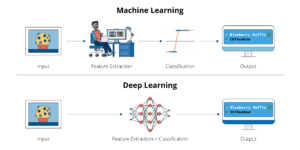Training
In the blog post Configuring a Neural Network Output Layer we highlighted how to correctly set up an output layer for deep learning models. Here, we discuss how to make sense of what a neural network actually returns from the output layers. If you are like me, you may have been surprised when you first…
Read MoreIntroduction When we teach our foundational Python class, one of the things we do is make sure that our students know how to explore Python from the command line. This has several advantages. First, it reduces context switching – to figure out new stuff, students don’t constantly have to toggle between writing Python code and…
Read MoreIntroduction When I first started my machine learning journey, K-means clustering was one of the first algorithms I was introduced to – and it is still one of my favorites to this day. I was amazed at how elegant yet comprehensible the procedure was. There is something oddly satisfying about watching the cluster assignments and…
Read MoreIntroduction At Enthought we teach a lot of scientists and engineers about using Python and the ecosystem of scientific Python packages for processing, analyzing, and visualizing data. Most of what we teach involves nice, clean data sets–collections of data that have been carefully collected, scrubbed, and prepared for analysis. While we also mention in passing…
Read MoreIntroduction If you have used TensorFlow before, you know how easy it is to create a simple neural network model using the Keras API. Just create an instance of the Sequential model class, add the number of desired layers and accompanying layer nodes, define the activation functions to be used by each layer, and compile…
Read MoreOne of the best features of Python is that it is platform independent. You can write code on Linux, Windows, and MacOS and it works on all three platforms with no problems…mostly. Admittedly there are some issues. Most of these are from known operating system differences when accessing system subprocesses or dealing with various local…
Read MoreIntroduction So, you have data and want to get started with machine learning. You’ve heard that machine learning will help you make sense of that data; that it will help you find the hidden gold within. Before you start sifting through your metaphorical gold mine, you realize you still have some unanswered questions: How do I…
Read MoreSorting Out .sort() and sorted() Sometimes sorting a Python list can make it mysteriously disappear. This happens even to experienced Python programmers who use .sort() when they should have used sorted() instead. The differences between these two ways of sorting a list are presented in this blog. Author: Eric Olsen, Senior DTX Services Consultant and…
Read MoreDeep learning. By this point, we’ve all heard of it. It’s the magic silver bullet that can fix any complex problem. It’s the special ingredient that can take any bland or rudimentary analysis and create an immense five course meal of actionable insights. But, what is at the core of this machine learning technique? Is…
Read MoreDigital skills personas for success in digital transformation The digital skills mix varies widely across companies, from those just starting to invest in digital transformation initiatives, to ones well into their journey. Building a community of people who think digitally and are able to innovate and quickly prototype ideas is key to delivering results. Author:…
Read More- « Previous
- 1
- 2
- 3
- Next »









